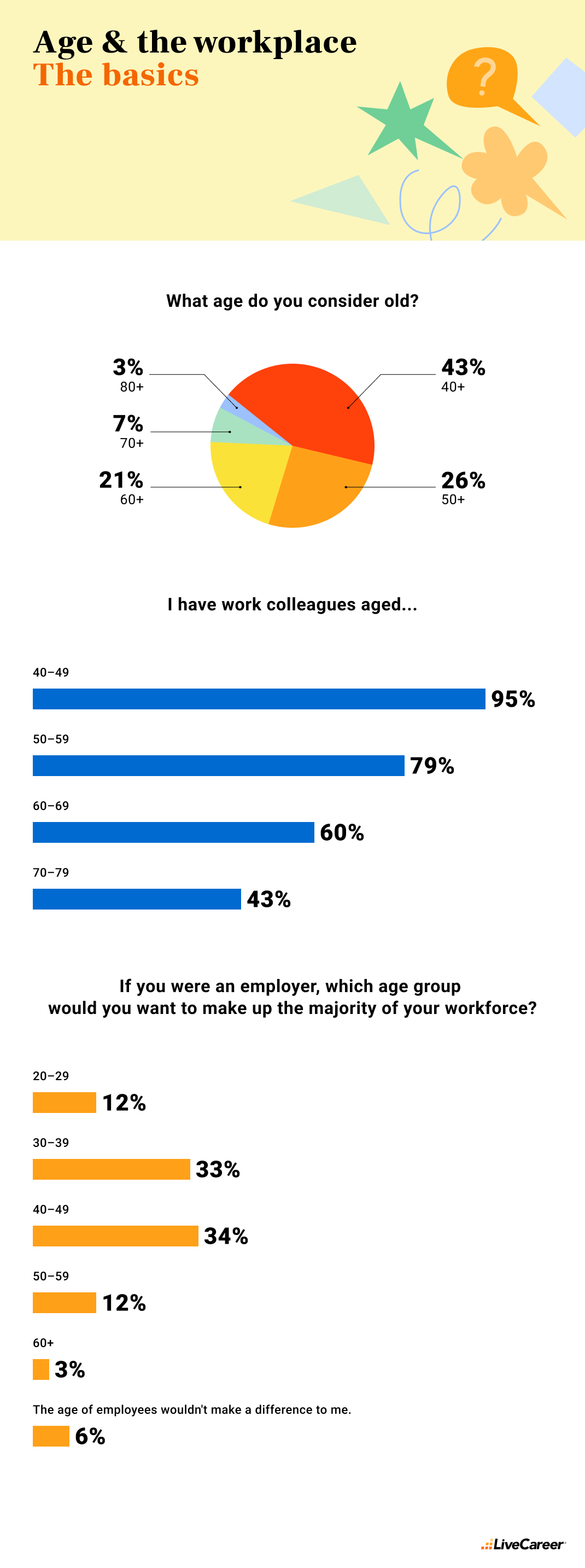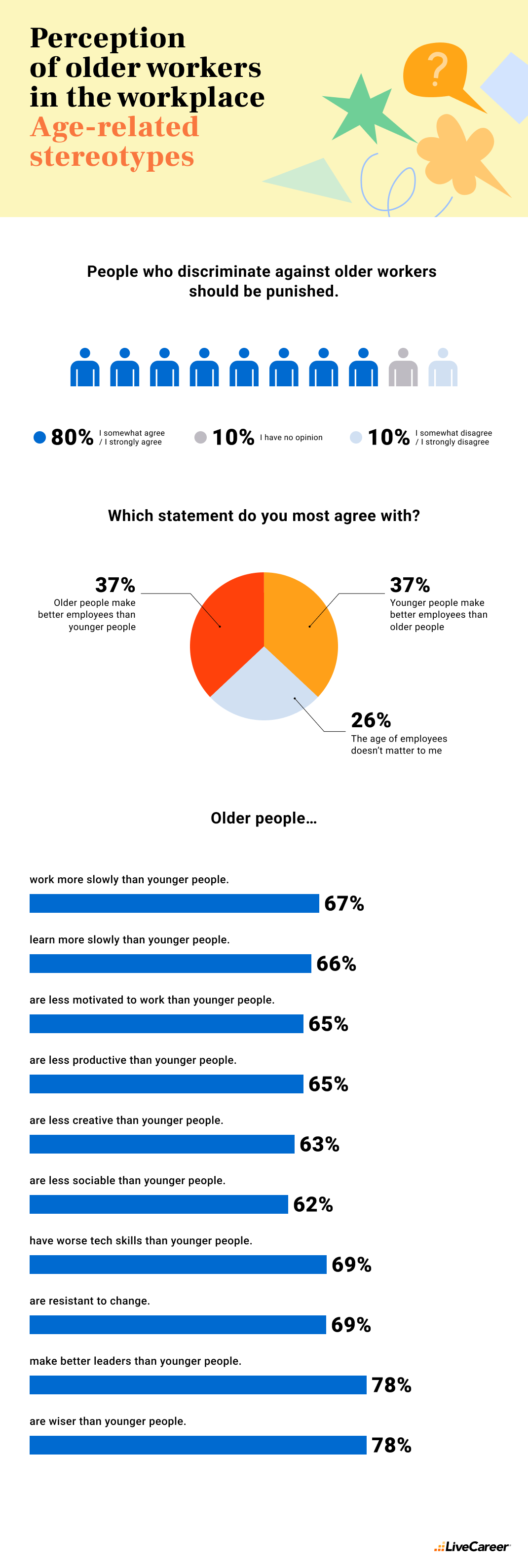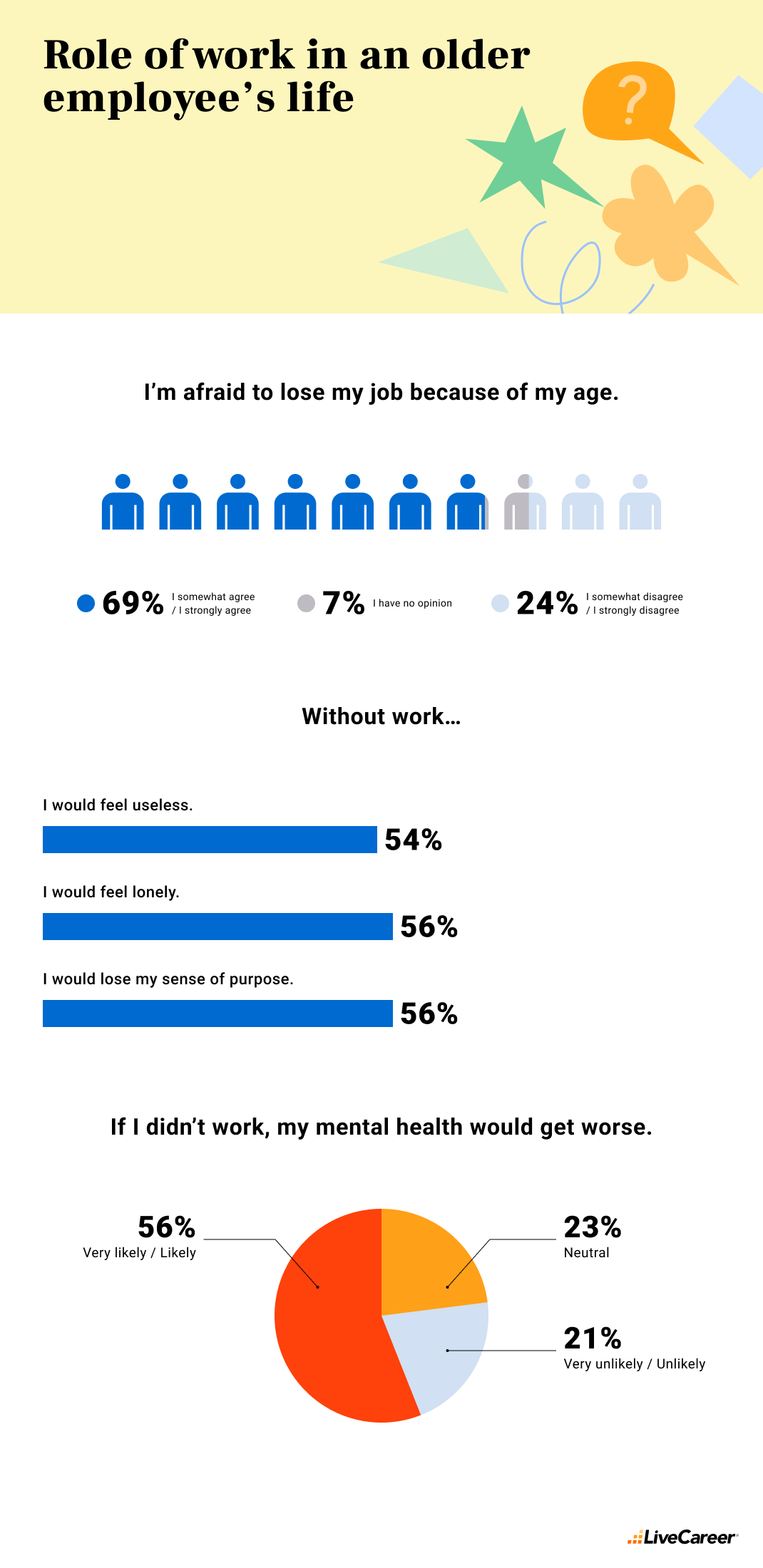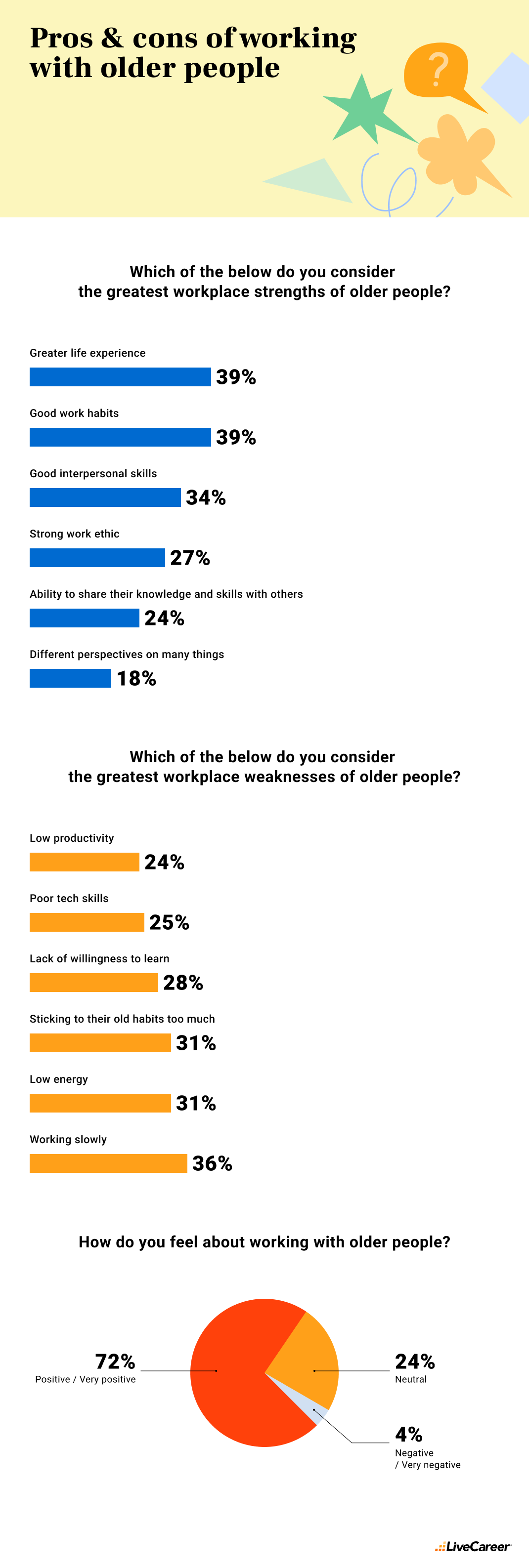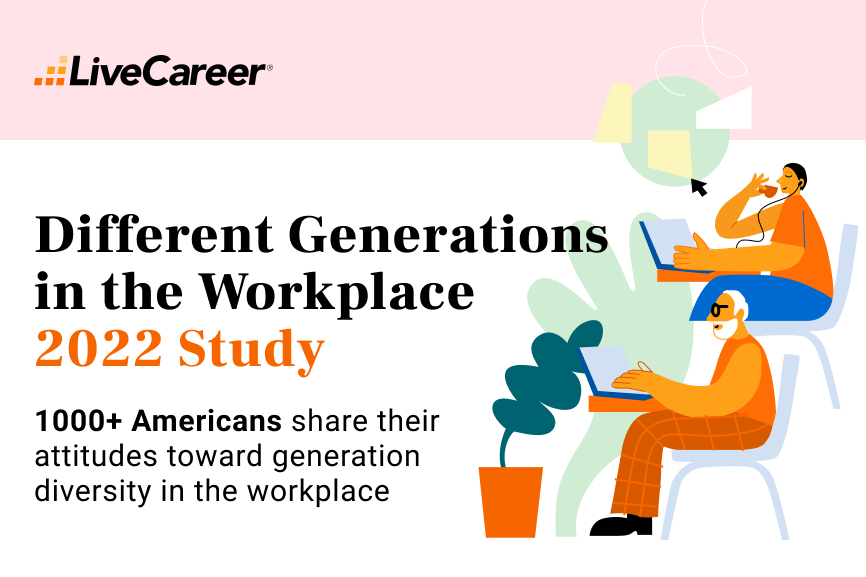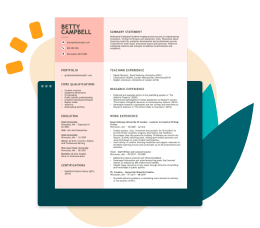Older People & the Workplace | 2022 Report
How does the saying go? “The only two certainties in life are death and taxes”.
Oh, wait. There’s a third one happening in the meantime. Aging.
No one can escape it, though many have tried. An elixir of youth sounds like a dream come true, but it works only in fairy tales. In reality, we’ll all get there.
To the first wrinkle, the first gray hair, and the first time someone suggests we’re too old for that job.
According to the OECD:
What does it mean in practice to the older workers? Let’s have a closer look at this burning issue.
At LiveCareer, we surveyed over 1,000 employees to investigate opinions about older people in the workplace. Keep reading to discover what our study revealed on the topics of:
- Workplace ageism
- Age-related stereotypes
- Perception of older employees in the workplace
- Labor market struggles of people aged 50+
- Age diversity in the workplace
But—
Before we move on to our research, let’s briefly examine some other studies on workplace ageism first.
- According to The World Health Organization, around 6.3 million cases of depression globally are attributed to ageism.
- Older people’s fears of losing a job are growing. Businesses want to save money and cut costs. One of the ways of achieving it is by getting rid of middle management. These are usually employees aged 40+.
- According to the Generation 2021 Annual Report, individuals aged 45+ make up a high share of the long-term unemployed. What’s more, the challenges and experiences of 45+ individuals are global, displaying striking consistency.
- 2022 data from AARP reveals nearly 80% of older employees reported they’d seen or experienced age discrimination in the workplace. The highest share since the group began asking the question in 2003.
- According to the BLS, the labor force growth rates of those 55 and older are projected to outpace all other age groups over the 2020-2030 decade.
And what did LiveCareer’s study reveal? It’s high time to find out.
Age & the workplace
First things first. To start with, we asked respondents what age they considered old. It turned out that:
- For as many as 43% of survey takers, turning 40 is the moment when you officially become old.
- At the same time, 1 in 4 (26%) respondents declared that it happens on your 50th birthday.
- 21% claimed that old age starts at 60, 7% — 70, while for 3%, old is 80 years and up.
Interestingly, it seems that the perspective depends on a respondent’s age.
- For the majority (39%) of those born in 1972 or earlier, old age started at 50. 33% believed it was at 40.
- Conversely, for almost half (48%) of respondents born in 1973 or later, 40 was enough to classify someone as old, while only 1 in 5 (19%) survey takers claimed that old age started a decade later, at 50.
We also asked a question about whether our respondents worked with “older” people:
- The vast majority (95%) of the surveyed had work colleagues aged 40–49.
- 79% of respondents worked with people aged 50–59, 60% with those who were 60–69 years old, while slightly more than 4 in 10 (43%) had employees older than 70 in their workplace.
Our study also revealed some interesting facts about certain industries and workplace age diversity.
- The education industry is the most age diverse. 85% of respondents had work colleagues aged 50+, 81% aged 60+, and 62% aged 70+.
- On the contrary, in software/IT, the percentage of employees aged 60+ and 70+ was noticeably lower than in other industries. Just over half (51%) of survey takers from the software/IT industry claimed they had colleagues aged 60–69, while only 36% worked with people aged 70 and more.
When asked: “If you were an employer, which age group would you want to make up the majority of your workforce?”, respondents gave the following answers:
- Employees aged 20–29 – 12%
- Employees aged 30–39 – 33%
- Employees aged 40–49 – 34%
- Employees aged 50–59 – 12%
- Employees aged 60+ – 3%
- Age of employees wouldn’t make a difference to me. – 6%
So the sweet spot seems to be somewhere between 30 and 50. Perhaps it’s just the right balance between youth and experience.
However, there was a big difference between answers given by respondents aged 40 or younger and those 41 and up. Let’s have a look:
- Younger people (40 and less) would want the following age groups to make up the majority of their workforce: 30–39 – 45%, 40–49 – 25%, and 20–29 – 15%.
- Conversely, for respondents aged 41 and more, the chosen age groups of employees would be as follows: 40–49 – 42%, 30–39 – 24%, and 20–29 – 9%.
Which brings us to the most unpleasant aspect of being an older person in the workplace. Time to focus on workplace ageism.
Workplace ageism in numbers
Age discrimination at work is real. Let’s face it. Our study leaves no doubt about it.
- Almost half (49%) of respondents claimed they had experienced age discrimination. What’s even worse, an additional 12% had both experienced and seen workplace age discrimination.
- Nearly 1 in 4 (23%) survey takers had seen (but not experienced) workplace age discrimination.
- Only 16% of the surveyed were lucky enough not to have experienced or seen workplace age discrimination.
- The highest percentage (64%) of people who have experienced workplace age discrimination are those working in the educational sector.
Terrifying. If that wasn’t enough:
- More than 7 in 10 (72%) respondents claimed that older employees were a target for workplace bullying. The situation was especially bad according to 85% of manufacturing workers surveyed.
On a positive note, 9 in 10 respondents agreed that people who discriminate against older workers should be punished.
But what punishment fits the crime? Here are our respondents’ favored options:
- Fine – 29%
- Community service – 24%
- Official reprimand – 18%
- Disciplinary dismissal – 13%
- Probation – 12%
- Other – 4%
Digging deeper:
- 1 in 5 respondents working in the healthcare industry chose disciplinary dismissal as the best penalty for workplace age discrimination. The percentage drops to 8% in the same option choice of survey takers from the educational sector.
- Interestingly, there were significant differences between answers given by Democrats and Republicans. The fine was considered the best penalty by 35% of Democrats and 25% of Republicans. At the same time, community service seemed the most adequate penalty type for 20% of Democrats and 27% of Republicans. The last disparity in the given answers regarded probation, chosen by 17% of Republicans and 11% of Democrats.
The last question concerning penalizing workplace age discrimination was, “What type of penalty should be applied to organizations/corporations that discriminate against older workers?” Here’s what our respondents viewed as the best option:
- Payment of compensation to employees who are discriminated against – 74%
- Fines – 61%
- Public naming and shaming of organizations that discriminate against older people – 48%
- Other – 7%
Workplace discrimination should be punished. Unfortunately, it comes in many forms. Not all of them are equally obvious. Yet, they do the same harm.
Ladies and gentlemen, here come age-related stereotypes.
Perception of older workers in the workplace
You can’t teach an old dog new tricks. And so on and so forth. Sure, dogs are cute. But stereotyping is not.
Age-related stereotypes should be long gone. Still, they are not. Sad but true. Our study findings won’t dry your tears, sorry.
We asked: “Which statement do you most agree with?”. And we got a dead heat.
- Older people make better employees than younger people. – 37%
- Younger people make better employees than older people. – 37%
- The age of employees doesn’t matter to me. – 26%
There was some difference between different demographics though:
- More than half (52%) of respondents with over 20 years of work experience declared that older people made better employees than younger people. While for 40%, age didn’t matter, only 8% of those surveyed believed young employees were better than older.
Let’s take a closer look at age-related stereotypes and perceptions in the workplace. According to our respondents, older people:
- Work more slowly than younger people. – 67%
- Learn more slowly than younger people. – 66%
- Are less motivated to work than younger people. – 65%
- Are less productive than younger people. – 65%
- Are less creative than younger people. – 63%
- Are less sociable than younger people. – 62%
- Have worse tech skills than younger people. – 69%
- Are resistant to change. – 69%
- Make better leaders than younger people. – 78%
- Are wiser than younger people. – 78%
What’s worth noting, survey takers with over 20 years of work experience didn’t share the above-presented views. In each case of a negative generalization about older employees, their agreement with the given statement drops by approximately 15–20%. Not a great surprise. Considering long work experience, we can assume they’re “older people” themselves. They know their own worth and speak for themselves.
Some more research findings to highlight:
- 72% of people working in the educational industry believed older people were less creative than younger people.
- 75% of respondents from the manufacturing sector claimed older people learned more slowly than younger people. Also, exactly as many (75%) believed that the older are less motivated to work than the younger.
On the one hand, respect for their wisdom and leadership skills. On the other, accusations of poor productivity, being slow, no motivation to work and resistance to change.
Older employees’ life is not a bed of roses, as you see.
Too old to work, too young to retire?
Let’s focus on the workplace struggles of employees aged 50 and up. Our survey included a special section where they could share their personal opinions and first-hand experience. May their voices be heard.
We asked respondents born in 1972 and earlier a series of questions. The first part comprised agreement (%) with the given statements.
- I haven’t been hired for a job because of my age. – 77%
- I feel that most job postings are addressed to people younger than me. – 86%
- I have been fired because of my age. – 74%
- Finding a job is easier for young people than for older people. – 76%
- Employees younger than me prefer working with people around their age. – 79%
- I feel respected because of my age. – 80%
Respect matters, sure. But can it compensate for all the negatives?
The first problems appear the moment older people start a job hunt. And they don’t end there.
Role of work in an older employee’s life
Getting a job, keeping a job, losing a job. The sum of all fears.
Our respondents aged 50+ opened up on the role of work in their lives. And their worries were heartbreaking.
- I’m afraid to lose my job because of my age.– 69%
- Without work, I would feel useless. – 54%
- Without work, I would feel lonely in my life. – 56%
- Without work, I would lose my sense of purpose in life. – 56%
- If I didn’t work, my mental health would get worse. – 56%
Other interesting research findings to note:
- Women seemed more scared (73%) of losing their jobs because of their age than men (66%). Or maybe men were not as willing to reveal their true feelings as women.
- Losing a job would result in losing a sense of purpose in life for 68% of Republicans and 48% of Democrats. Also, 66% of Republicans and 53% of Democrats claimed that if they didn’t work, their mental health would get worse. A disparity between answers given by Democrats and Republicans aged 50+ may suggest a great difference in attitude to work itself.
For many people, work is something more than money. It affects their general well-being and serves as an important part of their whole life.
In their own words
Our helpful survey takers had a chance to tell us, in their own words, how it feels to be an older employee in the workplace.
For some of them, age discrimination is bread and butter.
Luckily, there are also those who feel great in the multigenerational workplace.
They’re not scared. They’re powerful.
Inclusive workplaces make everyone feel valued, appreciated, and needed, regardless of their age.
Comforting view. There is hope in this (work) life.
Let’s change perspective now and move on to the advantages and disadvantages of working with older people.
Pros & cons of working with older people
Time to go back to respondents from all age groups.
Working with older people feels positive for 72% of respondents. We also asked what exactly they considered the greatest workplace strengths and weaknesses of older people. Let’s start with the positives:
- Greater life experience – 39%
- Good work habits – 39%
- Good interpersonal skills – 34%
- Ability to share their knowledge and skills with others – 24%
- Strong work ethic – 27%
- Different perspectives on many things – 18%
Just a quick comment. Genders and political affiliation sometimes matter, as it shows. Greater life experience was chosen as the biggest workplace strength of older folks by 42% of Democrats and 31% of Republicans, as well as by 35% of males and 43% of females.
And here are the negatives:
- Working slowly – 36%
- Sticking to their old habits too much – 31%
- Low energy – 31%
- Lack of willingness to learn – 28%
- Poor tech skills – 25%
- Low productivity – 24%
The sooner we realize how precious cooperation between employees from different age groups can be, the stronger we become. It requires taking action, though. Providing the right policies and practices from employers and governments as well as strengthening social dialogue is a must. Once it happens, a multigenerational workforce can be a win-win solution.
General views on age diversity in the workplace
Last but not least—
Some research findings on age diversity in the workplace and related issues:
- 8 in 10 respondents agreed that age mattered in the workplace.
- Age discrimination was considered a serious problem by 77% of respondents.
- Interestingly, it seems that the bigger the company, the worse the problem gets. 86% of the surveyed working for a company hiring 201-500 claimed they viewed age discrimination as a serious problem, while the percentage dropped to 69% in the answers given by those employed in a smaller (1-50 employees) company.
- 80% of survey takers declared they would hire people representing different age groups if they were employers.
- Surprisingly, people with less work experience (1-2 years) were much more skeptical about multigenerational hiring than those with 20+ years of work experience (68% vs. 90%).
- Almost 8 in 10 (79%) respondents agreed that the acceptance of employees of different age groups was a greatly important workplace issue.
- According to 83% of survey takers, everyone should be treated equally in the workplace, regardless of their age.
- When asked, “Who is more like to face age discrimination in the workplace?”, 39% of the surveyed chose older people, 33% younger people, while 28% claimed that age discrimination could be faced in the workplace regardless of a person’s age.
- It seems everything is a matter of perspective, though. For 48% of the youngest group of respondents, younger people were more likely to be discriminated against in the workplace. At the same time, 56% of the oldest survey takers claimed exactly the opposite.
A rapidly aging workforce is a fact. Just a fact. Not a blessing, not a curse.
New circumstances call for new solutions. And the simplest ones often turn out the best. A human-centered approach always pays off. It seems to us that empathy is the key.
Let’s refer to Steve Jobs now. He was right – death is the destination we all share.
Still, there are many more aspects of life that will reach everyone. Sooner or later.
Aging is one of them. We’re on the same boat, even if we haven’t reached the same destination.
Key takeaways
- For as many as 43% of survey takers, turning forty is the moment when you officially become old.
- Almost half (49%) of respondents claimed they had experienced age discrimination themselves. What’s even worse, an additional 12% had both experienced and seen workplace age discrimination. The highest percentage (64%) of people who have experienced workplace age discrimination are those working in the educational sector.
- More than 7 in 10 (72%) respondents believed that older employees were a target for workplace bullying.
- 37% of survey takers considered greater life experience and good working habits as the biggest workplace strengths of older people. Conversely, 36% of respondents viewed working slowly as their biggest weakness.
- 74% of the respondents aged 50+ declared they had been fired because of their age.
- Almost 9 in 10 (86%) survey takers aged 50+ felt that most job postings were addressed to people younger than them. At the same time, 76% believed that finding a job was easier for young people than for older people, and 77% claimed they hadn’t been hired for a job because of their age.
- More than half of respondents aged 50+ declared that without work, they would lose a sense of purpose (56%), feel useless (54%), and be lonely (56%) in their life.
- Age discrimination was considered a serious problem by 77% of respondents.
Methodology
The above-presented findings were obtained by surveying 1050 American respondents online via a bespoke polling tool. They were asked questions about their opinions about the situation of older employees in the workplace. These included yes/no questions, scale-based questions relating to levels of agreement with a statement, questions that permitted the selection of multiple options from a list of potential answers, and a question that allowed open responses. All respondents included in the study passed an attention-check question.
Limitations
The data presented relies on self-reports from a randomized group of respondents. Each person who took our survey read and responded to each question without any research administration or interference. There are many potential issues with self-reported data like selective memory, exaggeration, attribution, or telescoping. Some questions and responses have been rephrased or condensed for clarity and ease of understanding for readers.
Fair use statement
Want to share the findings of our research? Go ahead. Feel free to use our images and information wherever you wish. Just link back to this page, please—it will let other readers get deeper into the topic. Additionally, remember to use this content exclusively for non-commercial purposes.
Sources
- Chiesa, R., Zaniboni, S., Guglielmi, D., and Vignoli, M., “Coping With Negative Stereotypes Toward Older Workers: Organizational and Work-Related Outcomes”
- CIPD 2022 Report, “Understanding Older Workers. Analysis and Recommendations to Support Longer and More Fulfilling Working Lives”
- Kelly, J., “Study Shows Ageism Pushed Older Workers Out Of The Job Market During The Pandemic”
- Mourshed, M., Jaffer, A., Cashman, H., Salazar Ruiz, K., and Sikes, J., “Meeting the World’s Midcareer Moment”
- Nova, A., “How Older Workers Can Push Back against the Reality of Ageism”
- OECD, “Promoting an Age-Inclusive Workforce. Living, Learning and Earning Longer. Action Plan”
- SHRM, “Employing Older Workers”
About Us
LiveCareer is dedicated to getting you hired faster, no matter your industry or level of experience. Our easy-to-use Resume Builder and professional resume templates will help you every step of the way in your career journey.



